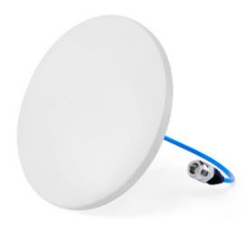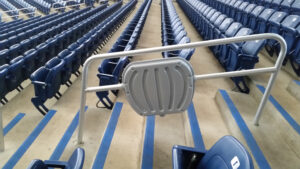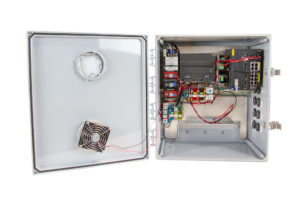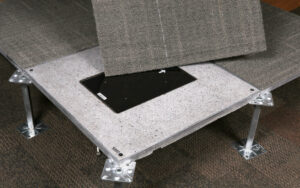When building a network, an engineer not only needs to understand how technology works, but they must also understand the use cases and applications, user profiles, topology, interference and attenuation obstacles, an assortment of other considerations, and any challenges unique to the location. Once all these understandings are translated into a vision for a functional, robust, and reliable network that provides the highest customer satisfaction, then the correct tools and equipment are required to execute the vision within the allocated budget. Ventev understands these challenges and designs products that keep customer satisfaction at the forefront. This week the DAS network challenges are explored alongside the Ventev DAS antennas and Accessories that are designed to counter and solve those challenges.
CHALLENGE: THE “MULTI’S”
Most facilities have more than one communications capability resulting in multiple “multi’s.” Whether a major red, blue, or magenta carrier or a local service provider, multi-operators are popular and, in many cases, essential to the network’s purpose. In addition to the operators, the available technology crosses multiple possibilities in network and device availability. Some combination of LTE, 5G, Wi-Fi, and so on are expected to be available for fixed and mobile devices across an array of use cases. To round out the “multiple” options are the many frequencies available by operators and technology. Regardless if it’s an operator-licensed low band or unlicensed Wi-Fi, an antenna’s specifications are critical in determining how well the signal is sent and received. Antennas for each variation of operator, frequency, and technology can become overwhelming.
Understanding the definition of terms explains how the types of DAS are named. Passive equipment does not control the flow of electrons passing through them. Antennas, jumpers, splitters, and other passive devices simply allow electrons to flow through the path of least resistance. Active equipment controls electrons. Amplifiers, routers, fiber optics, and other active devices, in some way, change or control what an electron does to modify the signal passing through them.
VENTEV SOLUTION: MULTI-OPERATOR, MULTI-BAND, MULTI-TECHNOLOGY ANTENNAS
Ventev Wideband antennas support multiple frequencies from multiple operators across multiple technologies in high-quality and performance antennas with rigorous specifications for high efficiency to expand coverage and capacity. The DAS antennas are designed to avoid or minimize intermodulation issues.
CHALLENGE: COMPLEX BUILDINGS
DAS networks are customized for commercial, residential, enterprise, university, hospitality, transportation hubs, large public venues, and many other locations. Each location differs in square footage, user profiles and use cases, construction materials (e.g., concrete, drywall, and so on), mobility needs, user density, and priority, to name a few considerations. Concentrating signal where it is needed most and deploying the antennas in preferred locations requires options that can accommodate the many time-limited deployment options.
VENTEV SOLUTION: AN ASSORTMENT OF EASY-INSTALL OMNI AND DIRECTIONAL ANTENNAS
Ventev’s antenna solutions provide network designs the flexibility to focus coverage where it is needed with an easy install form factor and optional mounting accessories that can simplify deployment time and cost. Incorporating the multi-band and technology features: these high-quality and performance antennas are cost-effective. They can support multiple bands and technology that can reduce the number of antennas required.
CHALLENGE: NETWORK GROWTH
Networks are built for a maximum amount of throughput for certain coverage areas, so when unexpected usage steadily increases faster than expected, capacity concerns increase. Coupled with expanding coverage demands that may exceed the initial build, the challenges start to compound. Customer satisfaction requires rapid responses to growing demand, and in the case of public safety, meeting these challenges is critical.
VENTEV SOLUTION: RUGGED, FLEXIBLE, AND EASY INSTALLATION PRODUCTS
Ventev understands the challenges networks face in keeping up with growing demand and extending coverage in a timely manner. The selection of cost-effective, durable, high quality and performance antennas and accessories are designed to meet these needs in public safety and cellular networks as a one-stop-shop for antennas, jumpers, splitters, and other passive devices required to keep customer satisfaction high and to support mission-critical use cases and applications.
Ventev’s DAS antennas and accessories are designed with network challenges in mind. Whether a new build, expanding an existing network, or finally upgrading, Ventev has the products and knowledge needed. Find out more about Ventev solutions to your network challenges.
Simple and challenging are two sides of the same coin when it comes to pleasing fans in a Large Public Venue (LPV). On the surface, fans simply want to have fun and make memories, so the inherent excitement from witnessing a live performance in a public forum with others that share the same passion is a recipe for a universal great time. The interesting dynamic is that many LPV music, sports, and events attract fans in a range of fervor, demographics, and technical savvy, all with different visions on the best way to experience the occasion. To further complicate the scenario, the venue staff and organizers require infrastructure to support the attendees so the good times can keep a rollin. From a wireless network perspective, the challenges and benefits have never been more exciting, and getting the right network in place to support the gush of fans and their data-hungry devices while prioritizing the applications that keep staff in control is critical.
In the post-paper economy, cash and physical tickets are replaced with apps and digital transactions. Getting through the gate, fans need to access the internet to retrieve their tickets (if they save d their ticket as a screenshot or to a digital wallet, they likely experienced wireless challenges firsthand at an LPV). Staff relies on wireless connections to validate and sell entry tickets, process digital transactions for concessions and souvenirs through either card or app, and notify other staff if assistance is needed. Safety and security personnel require connectivity and mobility to keep crowds under control and provide medical assistance. When the event is over, calls, texts, and apps all compete to notify friends, family, or ride shares that it’s time to move on to the next location —all this to ensure that the fans have access to shared amenities and an orderly event.
Fans want amenities and order, but that’s not why they showed up. Fans showed up so they could lose themselves in the occasion. They want to send out selfies, upload videos to social media, live stream to followers, review replays, fact-check stats, search for the next show, play with virtual and augmented reality if — it’s offered, and the list goes on. Fans expect a network that prioritizes infrastructure, so everything runs smoothly, so they can enjoy the features and apps their device provides.
Delivering Wi-Fi to the Masses
Ventev believes that working closely with our clients empowers LPVs to customize and prioritize networks with high-quality and performance products that are rugged and easy to deploy. Find out how coverage, capacity, and aesthetics for your LPV will give the fans what they want
Building a network can make one feel like a first-time car buyer. Budget, performance, reliability, practicality, aesthetics, and more factor into the decision-making process. A sports car may seem fun and attractive, but not practical for a family of five. A compact may seem cost-efficient and reliable, but not useful for a construction company that needs to haul lumber and gravel. Similarly, building the right network relies on understanding technology options that best support your mission-critical use cases. Understanding the Distributed Antenna System (DAS) is essential in determining what network elements are right for your network.
A DAS is a network of antennas, usually in-building, that provides communications over a designated area and is different from a macro tower in that the macro is outdoor and has much higher power covering a wider area. A simple way to understand the difference between a macro tower and a DAS is to consider the difference between a fire hydrant and home faucets. The macro provides massive amounts of communications capability with high power over a large outdoor area like a hydrant that can supply massive amounts of water covering many properties with a firehose. The DAS provides more targeted coverage with lower power over a smaller area like faucets in a house supplying targeted amounts of water to sinks, tubs, showers, and so on. This example becomes a little more relevant when addressing why DAS is a better option than a macro site to provide indoor coverage – filling a washing machine with a firehose from the street, generally speaking, isn’t as good as connecting the machine to the utility faucet in the laundry room. Modern energy-efficient windows are designed to prevent sunlight, and subsequently radio signals, from entering a building, so designs to provide indoor coverage from outdoor sources are easily frustrated. Different types of DAS antennas can be placed in strategic locations in or around a facility to ensure devices receive the coverage and capacity they require. Different use cases and requirements have led to three basic types of DAS: Passive, Active, and Hybrid.
Understanding the definition of terms explains how the types of DAS are named. Passive equipment does not control the flow of electrons passing through them. Antennas, jumpers, splitters, and other passive devices simply allow electrons to flow through the path of least resistance. Active equipment controls electrons. Amplifiers, routers, fiber optics, and other active devices in some way change or control what an electron does to modify the signal passing through them.
Types of DAS
Subsequently, passive DAS connects a radio signal through passive equipment to distribute the signal across a facility or area. This type of DAS is lower cost and simple to design and deploy, but a drawback is some signal loss. Active DAS boosts and otherwise changes or retransmits signals through the facility or area and is much more complex to design and with more expensive equipment. Deployment costs are typically much higher since fiber optics are used, although an upside is stronger signal strength. A hybrid DAS is unsurprisingly a combination of passive and active DAS. Learn more about how your network can benefit with the right type of DAS.
Every school year, students of all ages count on tools and resources to help them achieve academic success. Well-stocked libraries and research materials, sufficient seating and food selection in the cafeteria, and social clubs and programs are a few examples of what they need every day to eventually graduate and become self-reliant. With technological advances supporting all education levels and all the way through post-graduate studies, wireless infrastructure has never been more beneficial and critical. The post-COVID education landscape has highlighted disparity among school systems, and many governments have responded with grants and funding to close the technology gaps to ensure students can learn and benefit from remote learning and onsite technology advancements. Let’s review some challenges and benefits learning institutions face when building networks to support their student and staff community with summaries on futureproofing, cybersecurity, and failover design.
Challenge #1: Meeting Current and Future Wi-Fi Network Needs
One of the major challenges institutions faces is designing a network that both meets current needs and addresses future requirements. A network that is inefficient and inflexible can limit devices and services for currently enrolled students and makes future curriculum and support options difficult to impossible to achieve. Online and cloud-based teaching resources are only as good as the accessibility and stability of the network that allows authorized users to access course materials and upload completed assignments and communicate with other members of the community with questions, answers, and discussion points. Futureproofing a network is a benefit that addresses current needs and builds a foundation network that is agile enough to incorporate new technologies under development. Understanding the available network options for DAS, Wi-Fi, and other wireless connectivity options supply the right building blocks to handle data-heavy usage in classrooms, research areas, sporting venues, and leisure spaces where students can access social media, games, and other streaming services. Students and staff have enough stress navigating through the curriculum and competitive learning landscapes without adding connectivity and throughput problems to their list of frustrations.
Challenge #2: Cybersecurity
Another major challenge that has been increasing in recent years is cybersecurity. Ransomware, data leaks, and other malicious activities have increased as the countries have moved to more remote and technology-based interactions. Physical and virtual security work hand in hand to ensure access is given and verified consistently to protect sensitive information and ensure the network is available whenever the student or faculty needs it. In addition to a physical network layer, institutions need to consider a cybersecurity team and or protocol that can immediately respond to a cybersecurity breach by using best practices to limit network access until the threat is contained and addressed. Building a private network with options such as CBRS in the United States brings higher security that can complement a Wi-Fi network with added bandwidth and partitioned access. Keeping sensitive access on CBRS and general use with Wi-Fi can allow an additional layer of security to users with the added benefit of prioritizing wireless resources.
Challenge #3: Failover Design
The final challenge to consider is failover design. Supplying alternate access to cloud and online-based resources minimizes lost time for classroom instruction and research access. Students have limited time to engage in new material before a new block of instruction is presented. At the same time, educators have limited time to introduce new material, access given assignments, post grades, and communicate with students and other faculty. A single-threaded network can grind progress to a halt if an outage prevents communication flow among community members. Additionally, multiple technologies across multiple bands allow subscribers to flow between checking grades, streaming sporting events to friends, and communicating with family. A single network that manages subscriber access across multiple platforms provides failover access to the resources the community needs while network issues are resolved, and full capabilities are restored.
The Solution
Ventev supplies a suite of solutions to address the network challenges that educational institution faces while providing the benefits private networks offer. Ventev’s Wi-Fi, DAS, and passive accessories enable schools to build a future-proof, secure, and flexible network that will empower students to succeed and supply cutting-edge tools to educators to facilitate learning. Find out how to leverage Ventev’s Wi-Fi and private network solutions to build the education network you need.

The two major themes in telecom are to build the right network and then keep it running. Granted, it’s an oversimplification for the litany of challenges both themes face, but complex problems must still be resolved to a simple answer to the question, ‘Is the network up?”. Some days it seems like the whole world wants to bring our networks down – if we include solar flare disruptions, then it’s not just the world but the sun too. This week we will keep the content terrestrial and cover one of the most fundamental concerns for the network: losing power.
Uninterruptible Power Supply
As a summary for the private network neophytes (we were all there once, so don’t feel bad), the network locations with critical missions may have a generator in case of power loss; however, large amounts of AC power suddenly disappearing from a power loss and reappearing when the generator turns on will likely damage or destroy sensitive telecommunications equipment. Therefore, an Uninterruptible Power Supply (UPS) is inserted between the AC power supply and the network equipment to seamlessly provide power as generators start up and provide additional time until the power is restored. The important facts about how the UPS keeps power supplied to the equipment are through a series of rectifiers (converts AC to DC power), batteries to supply temporary power, and inverters (converts DC to AC power) to maintain a stable source of necessary power type to the network equipment. The UPS prevents power surges and provides battery power until generators turn on or regular power is restored. Depending on various factors, a site may have a UPS for the entire facility, or it may have a UPS for specific network elements on a circuit that connects to a modest generator. Therefore, identifying what network elements are most critical will determine how the network is designed and help determine how mitigation contingency resources are allocated.
Ventev and HPE Aruba Partnership
Ventev partnered with HPE to offer an Aruba Integrated System with a built-in UPS to provide critical communications connectivity during a power outage. The combined solution integrates the ruggedized Aruba CX 4100i ethernet switch into various Ventev power solutions to form a single unit. The CX 4100i boasts (12) 1GB ports with (8) class 4 POE ports at 30W and (4) class 6 POE ports at 60W. When the system is connected to AC power, the CX 4100i performs at full deployment capacity. When power is interrupted, the Ventev power solution communicates with the CX 4100i to prioritize what ports should remain active to ensure the most critical communications links can stay up as the system conserves UPS power until AC power is restored.
The challenges we face to protect our networks are not going away, and Ventev works with technology partners and customers to resolve these challenges. Ventev offers cost-efficient high-quality and performance solutions that are easily deployed and enable networks to support critical communications and applications. We are here to help you overcome a range of network challenges.
Most wireless users want service everywhere, and some expect it everywhere. A few want to know or see how it happens. In the end, for most of us, wireless service is like air — seemingly everywhere and we forget it’s there until we don’t have it. One of the myriad network elements necessary to make coverage ubiquitous is the antenna. Reflecting on what drives its evolution will hopefully help us appreciate what it does and the things behind the modern and future antenna design.
The Evolution of Inconspicuous Wi-Fi
In the late 20th century, arguably, coverage was the focus. Cellular and Wi-Fi networks were small and had few users, so coverage was key to building relevance and usefulness. Once popularity increased, coverage was still important, but then capacity became an additional, and major focus. More people subscribed to a network means more devices fighting over a limited spectrum. To address popularity, coverage, and congestion concerns, more antennas were deployed. Users quickly started to realize how many antennas, both outdoor and indoor, are required to support the wireless appetites across all the spectrums we consume. Users noticed the antennas were changing the landscape and décor, and deployments were increasingly faced with pushback from communities that did not want technologies to obstruct their surroundings. They also did not want antennas everywhere, but they still expected omnipresent coverage — a dichotomy that causes headaches for many network architects and wireless professionals to this day. Subsequently, the next evolution for antennas became aesthetics. The two general options for antennas are to either be attractive or at least not detract from the surrounding aesthetic (i.e. be inconspicuous).
Aesthetically Innovative
Innovation helps prevent a choice between network and aesthetics. Ventev provides solutions that keep your network present without providing visual cues to users that an antenna is even in the same room. Find out how these modern Wi-Fi antennas can improve your network.
Jim Baker, Ventev Senior Electrical Engineer
July 2021
Lead-acid batteries are the most frequently used batteries in UPS systems. They are economical
components that have proven to be effective over many years in use. Lead-acid batteries do age
and their capacity slowly deteriorates until they need replacement.
Why do they deteriorate?
The most common problem is the sulfation of the battery plates. Sulfates are created and consumed as
part of the normal charging and discharging battery process. However, a residual amount of sulfate
can be left on the battery plates each cycle. This sulfate coating builds up over time and reduces the
useful area of the plates, which also reduces battery capacity. Additionally, the sulfation process is
accelerated if the batteries are left in a discharged state.
What else impacts the life of a battery?
A variety of other factors, like high temperatures, will cause a decline in battery capacity.
Battery temperature can rise significantly during high rates of discharge or high charge rates and
overcharging. In Sealed Lead Acid batteries this can cause the battery to swell, subsequently
warping the thin battery plates, and cause venting of hydrogen from the cells.
LONG PERIODS OF INACTIVITY
If the battery left is unused for an extended period, the electrolyte can experience stratification. In
this situation, the acid and water components in the battery electrolyte will separate with the acid
settling to the bottom of the cell leaving the water at the top. The higher acid concentration at the
bottom of the cell will corrode away plate material, reducing battery capacity, eventually leading to
battery failure. This situation can be avoided when the battery is in routine use because in the
discharge and charge processes small gas bubbles form that promotes mixing of the electrolyte.
Most of these conditions are not observable by monitoring the battery terminal voltage while in
standby mode. That results in an AC Line Down situation, where batteries are expected to back up
critical applications. These conditions will result in shorter runtimes, or in the worst case, an immediate
system shutdown.
How do people typically test batteries in the field now?
The two most popular tests are Run and Ohmic Tests. In a Run Test, the battery is either partially
discharged or fully discharged. From the runtime data collected, capacity can be determined directly.
An Ohmic Test is used to determine the battery’s internal impedance. In most cases, there is a
relationship between loss of capacity and increased battery impedance. This measured value can
be compared to the impedance value, as specified by the manufacturer, to arrive at an estimate of
the battery’s health.
Are there more expensive battery testing devices that can be used?
Ohmic Tests need to be capable of measuring the sub-milliohm variations in battery impedance with
high precision. This requirement tends to make them quite expensive. Additionally, not all capacity
issues can be resolved by this method. For example, an Ohmic Test on fully charged batteries may not
be able to differentiate between a battery that is 100 percent good and one that is reduced to 80
percent. This applies to batteries that may have relatively few cycles with plates still in good
condition but have been partially vented due to higher temperatures or overcharging.
What is the best way to truly test a battery’s health?
The most accurate evaluation of a battery’s health is to allow the batteries to power its respective
load and time the test to low voltage cut-off. This measurement is then compared to the original
design specification. However, this full discharge Run Test not only adds cycles to the battery, which
can decrease its capacity, running the battery down to a low state of charge also carries a
considerable risk of the system being unable to perform if a backup situation occurs.
How does the BTRM evaluate battery health? How does it know when to test the battery
and when not to? Why is this method the most effective?
The BTRM utilizes the Run Test method but limits the Run Test to a partial discharge window, about
20 percent or less, and from the collected data estimates the full runtime capability. This minimal
discharge limits any impact on battery health due to cycling and minimizes the risk of the batteries
not being ready for a backup situation. Additionally, the Run Test’s discharge and charge cycle help
offset the stratification issue caused by long-term inactivity.
THE BTRM PROACTIVELY SENDS EMAIL AND TEXT ALERTS TO A USER-SPECIFIED ACCOUNT.
When an alert is sent, does that mean my battery bank will fail? Or will it not meet the
defined battery backup time? Do I need to replace the batteries immediately? How much
time do I have to replace the batteries?
One of the primary advantages of having the BTRM monitor the capacity on a scheduled basis is
that the BTRM can better assess the battery’s health over time. For example, the BTRM allows you
to differentiate between a battery that continues to consistently perform, even at some reduced
capacity, but still beyond the standby requirement, or a battery that is showing a continual or
rapid decline.
The battery industry recommends replacing batteries that have reached 85 percent of their capacity.
However, having the information the BTRM provides allows you to potentially extend the lifetime
of batteries that have declined in capacity but remain stable performers.
November 25, 2020
The COVID-19 pandemic has been a game changer in the food service industry. It has caused a re-evaluation of how to get food to the consumer as dining in has become a less, if rarely, used option. Starbucks recently announced it will expedite the rollout of its new “Pickup” store concept, powered by mobile ordering, in response to the pandemic. It will also expand access to curbside pickup, drive-thru, and walk-up counters in less dense, suburban markets. These types of services, as well as line busting (the process of shortening or eliminating check-out lines by removing customers from the main line and allowing them to pay at a different area from the main checkout), will require outdoor Wi-Fi in order to be an efficient process. So, what wireless options are available to facilitate these services?
Existing Indoor Wi-Fi
Many establishments already have indoor Wi-Fi that can be used for outdoor services. This is the least expensive option as there is no cost associated with using the existing Wi-Fi to broadcast outside and it is the easiest to implement. While cost may be a driving factor for choosing to use this solution, there are some major drawbacks to consider. Is it possible to get a reliable signal outside to cover the areas where you will be performing services like curbside pickup, drive-thru, and line busting? Most likely not. The indoor Wi-Fi was probably designed to only cover the dining area and the signal does not travel far outside of the restaurant. Performance will be poor at worst and unreliable at best.
Wi-Fi MESH
Wi-Fi MESH is an easily deployable solution where you use a Wi-Fi access point (AP) as a repeater to convey wireless from the main AP to other devices. Sometimes this method works pretty well but for the most part it may be unreliable and perform poorly because it might not cover all of the areas outside of the restaurant that you want it to.
Using an AP Indoors with an Antenna Mounted Outdoors
This is a widely-used and highly-reliable option in the Wi-Fi industry. The AP is mounted inside the restaurant, a hole is drilled in the wall, and the antenna is mounted outside. The antenna and thus the RF signal is placed closer to the client devices to provide a better user experience. While this is a reliable solution, this scenario is also the most expensive solution. Budgeting must account for the costs of the AP, the antenna, cabling, mounts, and the labor to drill holes to get the cable outside to the antenna.
Using an Outdoor AP or Taking an Indoor AP Outside
This is an all-encompassing solution in which you take an IP67 rated device, outdoor AP, or indoor AP and enclosure, and mount it outdoors. The AP is close to the client devices and the focused RF with pattern variation (i.e. 60, 90, 120 degree or omni-directional patterns) can be achieved with the external antenna. This solution is highly reliable and ruggedized for the outdoor environment and only requires a single installation location. Although this is an outdoor installation, you will still need to provide a single penetration point for your Cat 6 cable for PoE and data connectivity.
Ventev Wi-Fi Solutions
Ventev has a portfolio of wireless infrastructure products, including antennas, enclosures, and cabling solutions to provide optimum outdoor Wi-Fi for the food service industry, from curbside pickup to line busting. Ventev recently released new antennas that specifically address this growing Wi-Fi market segment.
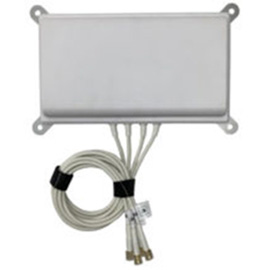
2.4/5 GHz, 6 dBi Flush Mount Directional Antenna (SKU 206570) with 4 RPSMA Male Connectors can be mounted outdoors on the facade of a building and provide a wide swath of coverage area.
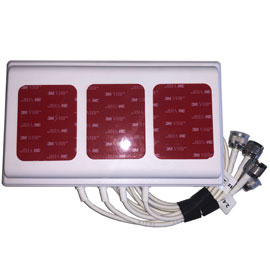
2.4/5 GHz, 6 dBi Directional Antenna (SKU 269463) with 4 RPTNC Connectors that mounts to glass. This antenna mounts on the inside of the restaurant, connects to an indoor AP, and propagates the RF signal outside through the glass. This is a great solution for curbside pickup.
To thrive in the current economy, the food industry, restaurants, and fast-food establishments in particular, must find other ways to serve their customers as indoor dining becomes less of the norm. Ventev has an ecosystem of products to help establishments provide outdoor Wi-Fi solutions to expand their service offering and customer base.

